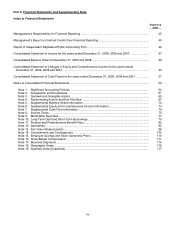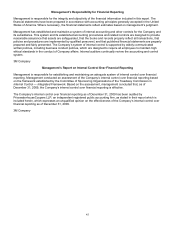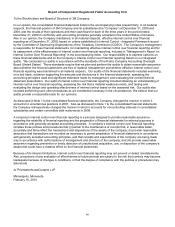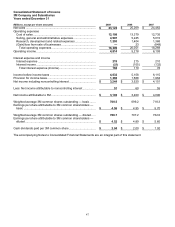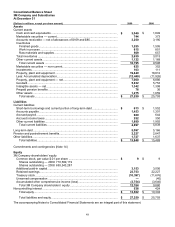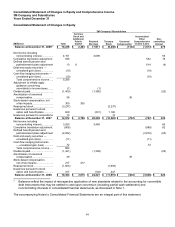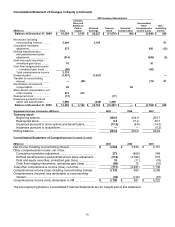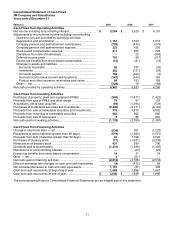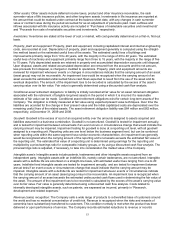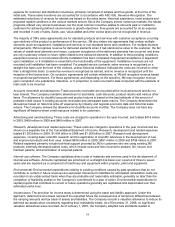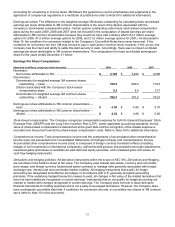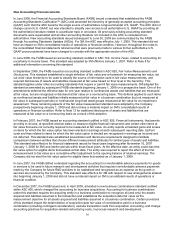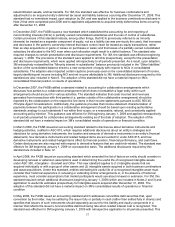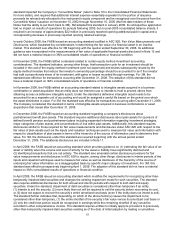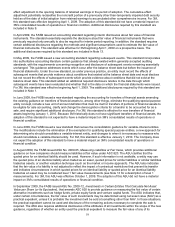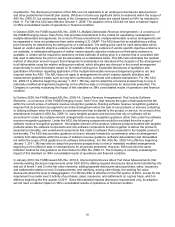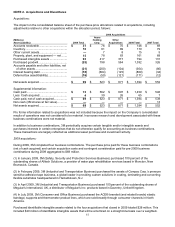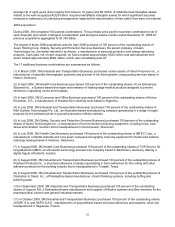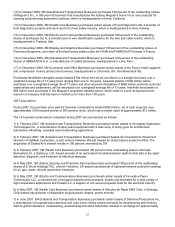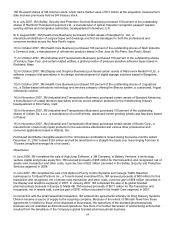3M 2009 Annual Report Download - page 60
Download and view the complete annual report
Please find page 60 of the 2009 3M annual report below. You can navigate through the pages in the report by either clicking on the pages listed below, or by using the keyword search tool below to find specific information within the annual report. 54
expense for customer and distributor incentives, primarily comprised of rebates and free goods, at the time of the
initial sale. These sales incentives are accounted for in accordance with ASC 605, Revenue Recognition. The
estimated reductions of revenue for rebates are based on the sales terms, historical experience, trend analysis and
projected market conditions in the various markets served. Since the Company serves numerous markets, the rebate
programs offered vary across businesses, but the most common incentive relates to amounts paid or credited to
customers for achieving defined volume levels or growth objectives. Free goods are accounted for as an expense
and recorded in cost of sales. Sales, use, value-added and other excise taxes are not recognized in revenue.
The majority of 3M’s sales agreements are for standard products and services with customer acceptance occurring
upon delivery of the product or performance of the service. 3M also enters into agreements that contain multiple
elements (such as equipment, installation and service) or non-standard terms and conditions. For multiple-element
arrangements, 3M recognizes revenue for delivered elements when it has stand-alone value to the customer, the fair
values of undelivered elements are known, customer acceptance of the delivered elements has occurred, and there
are only customary refund or return rights related to the delivered elements. In addition to the preceding conditions,
equipment revenue is not recorded until the installation has been completed if equipment acceptance is dependent
upon installation, or if installation is essential to the functionality of the equipment. Installation revenues are not
recorded until installation has been completed. For prepaid service contracts, sales revenue is recognized on a
straight-line basis over the term of the contract, unless historical evidence indicates the costs are incurred on other
than a straight-line basis. License fee revenue is recognized as earned, and no revenue is recognized until the
inception of the license term. On occasion, agreements will contain milestones, or 3M will recognize revenue based
on proportional performance. For these agreements, and depending on the specifics, 3M may recognize revenue
upon completion of a substantive milestone, or in proportion to costs incurred to date compared with the estimate of
total costs to be incurred.
Accounts receivable and allowances: Trade accounts receivable are recorded at the invoiced amount and do not
bear interest. The Company maintains allowances for bad debts, cash discounts, product returns and various other
items. The allowance for doubtful accounts and product returns is based on the best estimate of the amount of
probable credit losses in existing accounts receivable and anticipated sales returns. The Company determines the
allowances based on historical write-off experience by industry and regional economic data and historical sales
returns. The Company reviews the allowance for doubtful accounts monthly. The Company does not have any
significant off-balance-sheet credit exposure related to its customers.
Advertising and merchandising: These costs are charged to operations in the year incurred, and totaled $414 million
in 2009, $468 million in 2008 and $469 million in 2007.
Research, development and related expenses: These costs are charged to operations in the year incurred and are
shown on a separate line of the Consolidated Statement of Income. Research, development and related expenses
totaled $1.293 billion in 2009, $1.404 billion in 2008 and $1.368 billion in 2007. Research and development
expenses, covering basic scientific research and the application of scientific advances in the development of new
and improved products and their uses, totaled $838 million in 2009, $851 million in 2008 and $788 million in 2007.
Related expenses primarily include technical support provided by 3M to customers who are using existing 3M
products; internally developed patent costs, which include costs and fees incurred to prepare, file, secure and
maintain patents; and amortization of acquired patents.
Internal-use software: The Company capitalizes direct costs of materials and services used in the development of
internal-use software. Amounts capitalized are amortized on a straight-line basis over a period of three to seven
years and are reported as a component of machinery and equipment within property, plant and equipment.
Environmental: Environmental expenditures relating to existing conditions caused by past operations that do not
contribute to current or future revenues are expensed. Reserves for liabilities for anticipated remediation costs are
recorded on an undiscounted basis when they are probable and reasonably estimable, generally no later than the
completion of feasibility studies or the Company’s commitment to a plan of action. Environmental expenditures for
capital projects that contribute to current or future operations generally are capitalized and depreciated over their
estimated useful lives.
Income taxes: The provision for income taxes is determined using the asset and liability approach. Under this
approach, deferred income taxes represent the expected future tax consequences of temporary differences between
the carrying amounts and tax basis of assets and liabilities. The Company records a valuation allowance to reduce its
deferred tax assets when uncertainty regarding their realizability exists. As of December 31, 2009, no significant
valuation allowances were recorded. As of January 1, 2007, the Company adopted new standards related to


